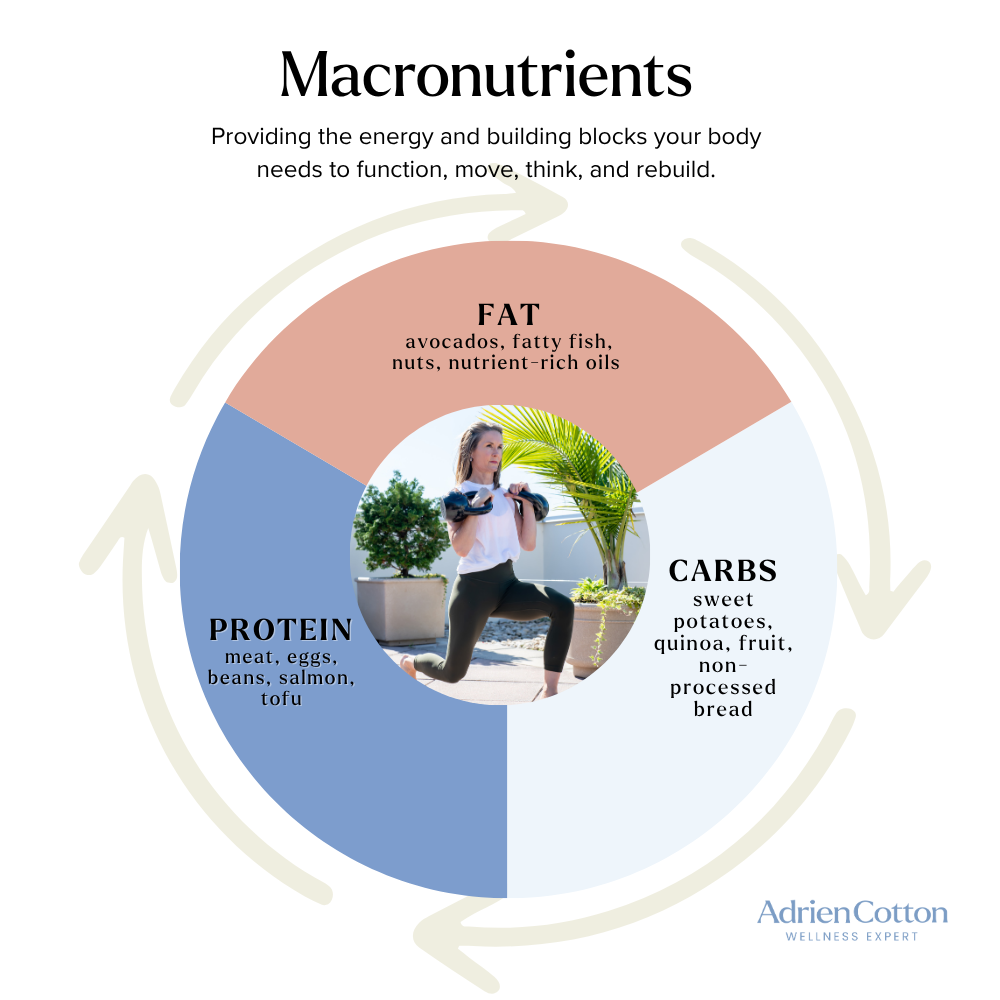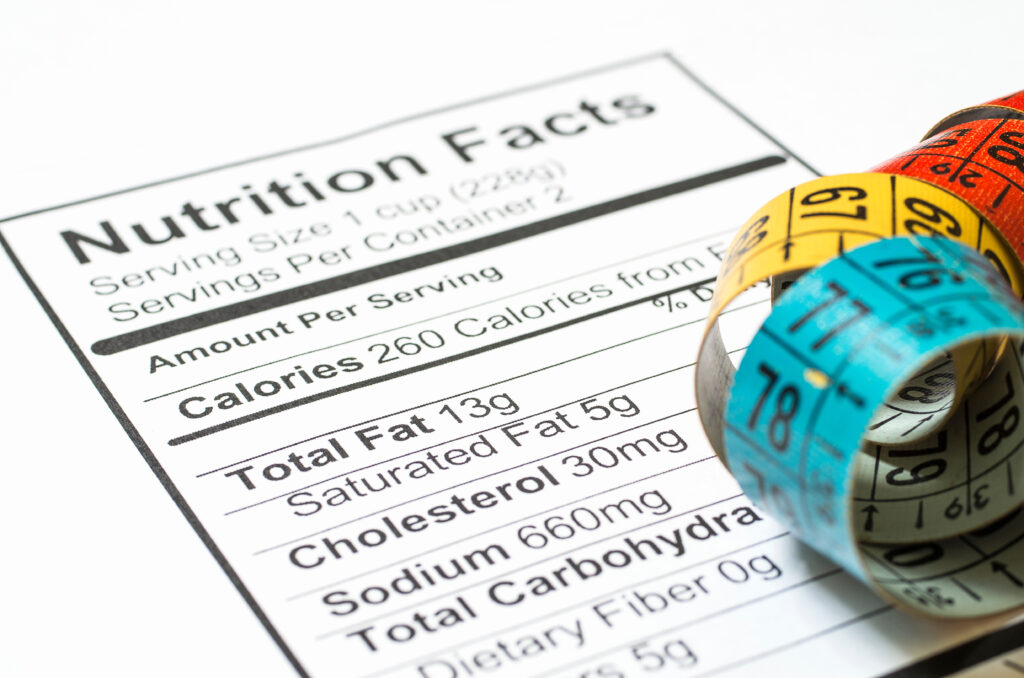 Weight loss or maintenance is almost always top of mind for women who seek my help. And while I always reframe that conversation into one about feeling your best, the food we eat is still a major part of the equation, and women want me to tell them what to eat and when to eat it.
Weight loss or maintenance is almost always top of mind for women who seek my help. And while I always reframe that conversation into one about feeling your best, the food we eat is still a major part of the equation, and women want me to tell them what to eat and when to eat it.
So today, I want to expand the conversation to the full picture: macronutrients. That’s the trio of protein, fat, and carbohydrates that we eat (ideally, in every meal!), and why understanding them is key to eating well and feeling good.
It’s not just protein??!
By now, you’ve heard me talk a lot about protein. From early blog posts to recent webinars, I’ve emphasized why ample protein is a non-negotiable ingredient for women over 40. And for good reason: it’s the cornerstone of muscle, strength, and staying lean as we age.
But I think you’re all ready to hear the expanded truth. Like all wellness, it’s not just about one thing, and of course, protein alone isn’t enough. We have to make a little room–in our brains, and on our plates, for our friends: carbohydrates and fats. And trust me, as you expand your knowledge, you can better manage all of your meals, and you will end up looking and feeling so much better than before.
What are macronutrients, anyway?
Macronutrients (or “macros”, as you’ve likely heard ALL over the web!) are the three categories of nutrients your body needs in large amounts.

Protein, fat, and carbohydrates. Macros.
Macros provide the energy and building blocks your body needs to function, move, think, and rebuild.
And no, tracking macros doesn’t mean you have to go “keto” or “paleo” or download an app tomorrow (unless that works for you). It’s not what the diet industry says you should eliminate, measure, or monitor. It just means learning what your body actually needs.
Fat is not the enemy: The background on its misrepresented name
Repeat after me: Fat is not the enemy. Fat got a bad rap only because it is the same word to describe someone who seems the opposite of thin. Let’s unpackage this a little more with some background:
Around the 1950s, scientists started to research why more Americans were suffering from heart disease. One emerging idea was that eating saturated fat and cholesterol increased blood cholesterol levels, which in turn raised the risk of heart disease. A physiologist named Ancel Keys advanced this “diet–heart hypothesis,” linking what we eat with our cardiovascular health. Although his research focused on heart disease risk, the message started to blur in the public eye into a broader belief that all dietary fat was unhealthy.

Forward to the period between 1970-1990s and what I like to call the ‘fat makes you fat’ era…
In 1977 the U.S. Government Dietary guidelines advised Americans to reduce total fat intake. This was, again, less about weight gain and more about heart disease, yet the message continued to merge together. Throughout the 1980s and 1990s, that ‘fat makes you fat’ message only grew stronger in marketing campaigns and government messaging.
Fortunately today, that message is being dissected, and we know any one component of eating is more than black or white, good or bad. While it is true that fat has higher calorie density than the carbohydrate, fat can also pack a powerful punch of nutrients.
I hope you can see how a simple study or activity can be twisted into a storyline that is really NOT TRUE. Healthy fats like avocados, olive oil, fatty fish, and nuts, do more than help you feel full. They help regulate hormones, support brain health, build muscle, and keep your skin, eyes, and joints functioning.
I recommend women in midlife aim for 25-30% of their intake from healthy fats. This isn’t a “cheat day” food. This is a necessity.
The 90’s called. They want carbs again.
Carbs have also been demonized for decades. Let’s end that nonsense now! Your brain runs on carbs. They give you quick, usable energy. They support hormone balance, mental clarity, and workout recovery. The problem isn’t carbs—it’s which carbs and when.
Right behind the “fat makes you fat” message came the low carb movement. And it is STILL around today!
This is what happened: In order to make foods palatable, fat was replaced with refined carbs–you all remember Snack Wells, fat free frozen yogurt, and sugary cereals, don’t you?
What happened? People ate more processed carbs, leading to spikes in sugar and insulin, which researchers linked to obesity and metabolic issues. So like fats, all carbs became the enemy.
But now we know this is not true! Aim for around 30-35% of your intake from carbohydrates–GOOD carbohydrates. That includes sweet potatoes, quinoa, fruit, and yes, even bread if it works for your body. Just don’t make ultra-processed options your go-to.
Protein, still the anchor
You’re probably sick of me proselytizing the power of protein, but protein still leads the pack. Why? Because muscle – produced through “protein synthesis,” is the currency of health—especially in midlife and beyond. We begin losing muscle in our 30s, and without intention, that loss accelerates. Muscle helps hormones, insulin sensitivity, metabolic rate, injury prevention and much much more!
My rule: get 30-40% of your intake from protein.
Greek yogurt + a scoop of quality protein powder? Great. Eggs, beans, salmon, tofu? Fantastic. Increase the amounts you’re eating by small steps. Repeat often.
“Can I actually do this?”

Now comes the real part. While I value habits, structure, and knowledge, I also know: My clients are busy. They’re running companies, raising kids, navigating menopause and aging parents. You don’t need to (or simply have time to) fill in a spreadsheet with what you’ve been eating.
So my advice is, at the end of the day, take a look at the rules, what you’ve done, and keep what works. Don’t track every bite or follow a rigid plan. Just be mindful.
You can start small:
- Add one protein-forward breakfast a week.
- Buy pre-cut veggies instead of promising you’ll prep on Sundays–bonus, grab those sweet potatoes and get in those “good,” nutrient-rich carbs!
- Sprinkle in healthy fats–avocados, oils, nuts–or extra protein in your lunch salads.
Aim for balance, not perfection. Remember: 80% consistency over time beats 100% effort that fizzles in a week.
The balancing act of food for life.
Over time, you will gain a better understanding of exactly what you are eating, and in what quantities, and achieve getting in 30% each of protein, fats, and carbohydrates per meal.
Food is power. And there is no perfect diet–you just need a sustainable one. Balanced macros will help you feel better, think more clearly, show up stronger, have more energy, focus, and just feel better as you step into your best midlife self!


